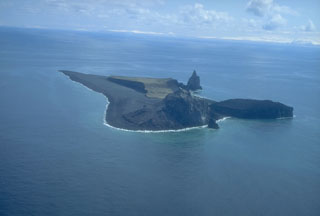Report on Bogoslof (United States) — 28 December-3 January 2017
Smithsonian Institution / US Geological Survey
Weekly Volcanic Activity Report, 28 December-3 January 2017
Managing Editor: Sally Sennert.
Please cite this report as:
Global Volcanism Program, 2016. Report on Bogoslof (United States) (Sennert, S, ed.). Weekly Volcanic Activity Report, 28 December-3 January 2017. Smithsonian Institution and US Geological Survey.
Bogoslof
United States
53.93°N, 168.03°W; summit elev. 150 m
All times are local (unless otherwise noted)
On 27 December AVO noted that since there was no indication of elevated seismicity at Bogoslof during the previous day the Aviation Color Code (ACC) was lowered to Orange and the Volcano Alert Level (VAL) was lowered to Orange. AVO noted that there is no ground-based volcano monitoring equipment on Bogoslof; activity is monitored by satellite images, information from the Worldwide Lightning Location Network pertaining to volcanic-cloud lightning, and data from seismic and infrasound instruments on other islands.
An increase of volcanic tremor started to be detected at 1755 on 28 December with the largest burst, recorded at 1807 and lasting 50 minutes. Inclement weather prevented satellite confirmation of accompanying emissions. The report noted that this type of seismic activity had accompanied each of the previous explosions at Bogoslof since the eruption began last week, prompting AVO to issue a Volcano Activity Notice (VAN) and Volcano Observatory Notice for Aviation (VONA) in case there was an ash plume released.
Another increase in seismicity began at 1900 on 29 December and progressed, merging into a continuous tremor sequence indicative of a possible ash-producing eruption. At 2345 a 30-minute-long, ash-producing event began, with an ash plume possibly rising as high as 6.1 km (20,000 ft) a.s.l. that drifted NE. The ACC and VAL were raised to Red and Warning, respectively. A 45-minute-long explosive event began at 2230 on 30 December, indicated by seismic data and lightning strikes. Meteorological cloud cover prevented satellite views. No further explosions were detected afterward, so on 1 January 2017 the ACC was lowered to Orange and the VAL was lowered to Watch. Increased seismicity detected at 1353 on 2 January and lasting about 10 minutes likely indicated a relatively minor explosion; meteorological cloud cover prevented visual observations.
Geological Summary. Bogoslof is the emergent summit of a submarine volcano that lies 40 km N of the main Aleutian arc. It rises 1,500 m above the Bering Sea floor. Repeated construction and destruction of lava domes at different locations during historical time has greatly modified the appearance of this "Jack-in-the-Box" volcano and has introduced a confusing nomenclature applied during frequent visits by exploring expeditions. The present triangular-shaped, 0.75 x 2 km island consists of remnants of lava domes emplaced from 1796 to 1992. Castle Rock (Old Bogoslof) is a steep-sided pinnacle that is a remnant of a spine from the 1796 eruption. The small Fire Island (New Bogoslof), about 600 m NW of Bogoslof Island, is a remnant of a lava dome formed in 1883.
Source: US Geological Survey Alaska Volcano Observatory (AVO)

